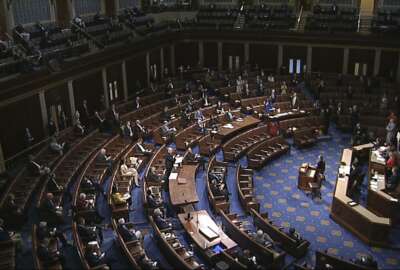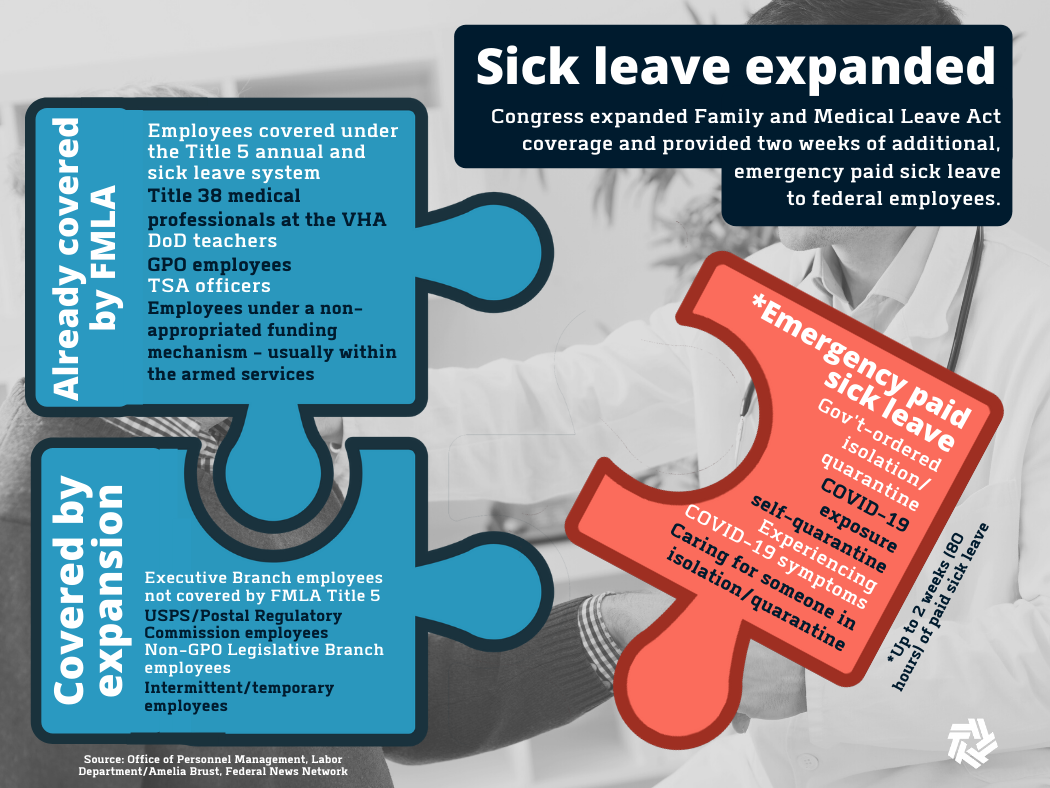
Know your new paid sick leave benefits during the coronavirus pandemic
Congress expanded some benefits and added emergency paid sick leave in the Families First Coronavirus Response Act, but the details for federal employees are...
Congress has given federal employees a few more options to take paid sick leave or time off to care for their children at home due to the coronavirus.
The Families First Coronavirus Response Act, which Congress passed into law March 18, includes two important benefits for federal employees — emergency paid sick leave and an expansion of the Family and Medical Leave Act.
Let’s start with the Family and Medical Leave Act expansion.
What this expansion means for you ultimately depends on where you work and what leave benefits you had before the coronavirus pandemic began.
For the purposes of explaining these leave benefits, there are two categories of federal employees — those covered under Title 1 of the Family and Medical Leave Act (FMLA) and those covered under Title 2 of the FMLA.
The first category includes Postal Service and Postal Regulatory Commission workers and legislative branch employees, including those at the Library of Congress and the Government Accountability Office, but not those at the Government Publishing Office. It also includes intermittent work employees, as well as those hired under a term or temporary appointment, according to April 7 guidance from the Office of Personnel Management.
Because these employees have limited benefits under Title 1 of the FMLA, they are eligible for the expanded Family Medical and Leave Act coverage Congress included in the Families First Coronavirus Response Act.
Under the expanded coverage, federal employees in this category can receive 10 additional weeks of family and medical leave to care for a child whose school or care provider is closed due to the conronavirus pandemic.
The first 10 days of expanded FMLA leave coverage is unpaid, but employees can substitute the time either with their own accrued paid sick leave or the emergency paid sick leave Congress also passed.
Expanded FMLA leave will be fully or partially paid, depending on an employee’s individual cirumstances.
“These employees must have been employed for at least 30 calendar days with the employer
from whom leave is being requested,” OPM said in recent guidance on the topic.
The typical FMLA provisions that require an employee to have at least 12 months service and 1,250 hours of service with the employer during the previous 12-month period don’t apply here, according to OPM.
Then there are the employees covered under Title 2 of the FMLA, the majority of the civilian federal workforce.
This includes Title 5 workers.
But it also includes Title 38 medical professionals at the Veterans Health Administration, Defense Department teachers, Government Publishing Office employees and transportation security officers at the Transportation Security Administration. These employees are technically employed under different personnel systems, but they’re covered under Title 5 FMLA provisions.
For this group of employees, nothing changes. They still have access to their full slate of paid and unpaid leave benefits under the Title 5 FMLA system, and therefore, they don’t have access to expanded leave Congress included in the Families First Coronavirus Response Act.
The Labor Department is implementing the FMLA expansion. The expansion runs through Dec. 31, 2020.

In addition, Congress provided up to two weeks, or 80 hours, of paid or partially paid sick leave to all federal employees — but only in specific circumstances.
Emergency paid sick leave is available through Dec. 31, 2020.
This leave is in addition to the leave many federal employees have under the Family and Medical Leave Act, regardless of their coverage under that act.
Federal employees can use the new emergency sick leave because they’re unable to work or telework for the following coronavirus-related reasons:
- They’re under a federal, state or local isolation or quarantine order,
- They’ve been advised by a health care provider to self-quarantine due to coronavirus concerns,
- They’re experiencing coronavirus symptoms,
- They’re caring for someone who has been directed to isolate or self-quarantine,
- They’re caring for their child whose school or care provider is closed due to the pandemic, and
- They’re experiencing another similar condition as specified by the Department of Health and Human Services.
Federal employees who use this emergency sick leave for reasons 1 through 3 will be fully paid. Using leave for reasons 4 and 6 will earn employees two-thirds of his or her regular pay.
The scenario is trickier for employees who want to use this leave for reason 5. Federal employees who are eligible for the expanded FMLA benefits as explained above can use those new benefits.
The Title 5 employees and others who already have FMLA coverage can take leave for reason 5, but they’ll be paid at either federal or state minimum wage or two-thirds of normal pay rate, whichever is higher.
Part-time federal employees are eligible for leave based on the number of hours they’d typically work under normal circumstances.
Agencies can choose to exclude health or emergency responders from emergency paid sick leave coverage, OPM said. The director of the Office of Management and Budget may also exclude federal employees from this leave for “good cause.”
Labor is also implementing this emergency paid sick leave, not OPM. Labor has a fact sheet with more information, which can be found here.
Copyright © 2025 Federal News Network. All rights reserved. This website is not intended for users located within the European Economic Area.
Nicole Ogrysko is a reporter for Federal News Network focusing on the federal workforce and federal pay and benefits.
Follow @nogryskoWFED
Related Stories




